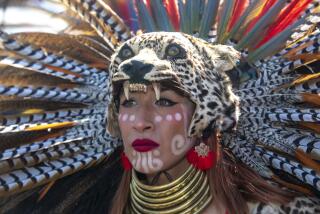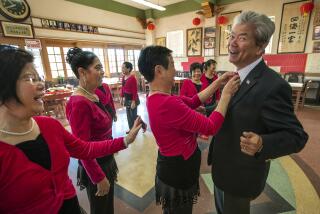Young Hmong Gather to Celebrate New Year
- Share via
SANTA ANA — Seeka Wong Yang, 22, wore a delicate black velvet pantsuit, trimmed with hand-embroidered sashes flashing shades of bubble gum pink, lime green and deep violet. Her ornate dress, a 5-pound silver neckpiece and the dozens of coins that jingled from her neck signified that she was unmarried.
On Friday, she joined scores of other young women and men, boys and girls in similar dress at the second annual Hmong New Year’s Celebration at Rancho Santiago College in Santa Ana. The three-day event, celebrating the most important holiday in Hmong culture, began Thanksgiving Day and drew revelers from as far as Wisconsin and Minnesota.
“The New Year is about chasing out the bad from last year and welcoming good luck and hope for the new year,” said Chongge S. Vang, president of the United Lao Movement for Democracy, which organized the event.
Originally from China, the Hmong are one of the most ancient tribes in the world. Persecuted in China for refusing to discard their unique ways, they migrated to the highlands of Laos in the early 1800s. As war ravaged Southeast Asia in the mid-1970s, they fled to refugee camps in Thailand.
More than 125,000 now live in the United States, primarily in California and Minnesota. About 88,000 Hmong refugees and their children have settled in California.
Before Fresno County became home to the largest Hmong population in the nation, Orange County during the 1980s was known for having a sizable Hmong community. The migration north has shrunk the community to about 3,000 in Orange County, making events such as this week’s New Year’s celebration even more necessary, supporters said.
“It’s hard to keep up with our culture because we don’t see a lot of Hmong people here,” said 17-year-old Ger Yang of Garden Grove. “This is a way to meet new friends and remember our heritage.”
And new friendships were spawned Friday through a traditional Hmong icebreaker called “ball tossing,” in which a bachelor meets a single woman by tossing a ball to her.
Ger Yang, who wore a customary outfit gilded with coins and bright beads strung by his mother to signify his bachelorhood, approached Michelle Moua, 17, and greeted her bashfully. Standing about 3 yards apart, they began to throw a tennis ball back and forth. A conversation began, they exchanged names, asked introductory questions and giggled.
In their homeland, ball tossing is a formal courtship, Seeka Wong Yang of Santa Ana said. In the United States, it is a way to find new friends and potential romances.
But the ball game is one reason she comes to this annual gathering, Seeka Wong Yang said. The dance, music, food vendors and handmade clothing expose her to something new.
The clothing, for instance, does not only signify one’s marital status: The colors identify the wearer’s region of origin, and ornateness and the number of coins signify the person’s social status. Only single people wear the outfits.
The Hmong New Year, which follows a lunar calendar, actually will fall on Dec. 26 this year. Although the celebrations in Santa Ana end today, participants said another major event is planned after Christmas in Fresno.
“That’s the biggest event,” Seeka Wong Yang said gleefully. “It’s like a massive pilgrimage to Fresno.”
More to Read
Sign up for Essential California
The most important California stories and recommendations in your inbox every morning.
You may occasionally receive promotional content from the Los Angeles Times.













